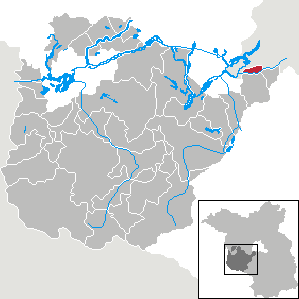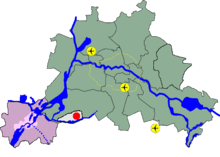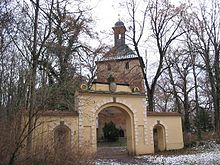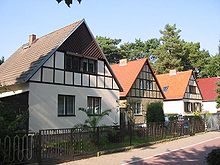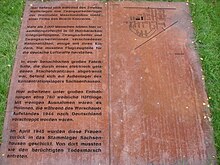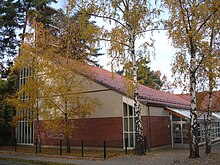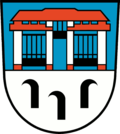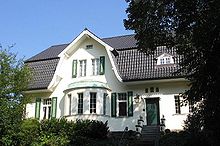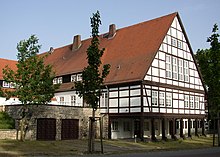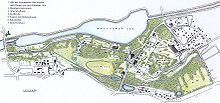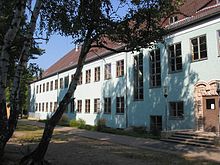Kleinmachnow
| coat of arms | Germany map | |
|---|---|---|

|
Coordinates: 52 ° 25 ' N , 13 ° 14' E |
|
| Basic data | ||
| State : | Brandenburg | |
| County : | Potsdam-Mittelmark | |
| Height : | 45 m above sea level NHN | |
| Area : | 11.91 km 2 | |
| Residents: | 20,376 (Dec. 31, 2019) | |
| Population density : | 1711 inhabitants per km 2 | |
| Postal code : | 14532 | |
| Area code : | 033203 | |
| License plate : | PM | |
| Community key : | 12 0 69 304 | |
| LOCODE : | DE KLW | |
| Community structure: | 2 districts | |
| Address of the municipal administration: |
Adolf-Grimme-Ring 10 14532 Kleinmachnow |
|
| Website : | ||
| Mayor : | Michael Grubert ( SPD ) | |
| Location of the municipality of Kleinmachnow in the Potsdam-Mittelmark district | ||
Kleinmachnow is a municipality with a good 20,000 inhabitants in the Potsdam-Mittelmark district in Brandenburg . It is located southwest of the Berlin district of Steglitz-Zehlendorf and east of Potsdam .
Mentioned for the first time in Charles IV's land book of 1375, the place played an important role in the Bäke crossing , which was secured by various medieval castles. The last of these castles, all of which have not been preserved, belonged to the Knights of Hake , whose family shaped local history up into the 20th century. The replacement of the Bäke by the Teltow Canal in 1906 gave the village the Kleinmachnow lock, which is now a listed building .
In the first half of the 20th century, Kleinmachnow grew from a rural Gutsdorf to a suburb of the agglomeration of Berlin . With the construction of the Berlin Wall in 1961, Kleinmachnow was cut off from the west of Berlin and was relatively isolated within the GDR due to its proximity to the border. Since the German reunification in 1990, Kleinmachnow has participated in the growth of the Berlin area.
geography
Geographical location
The municipality of Kleinmachnow is bounded in large parts by the Teltow Canal in the south , only along Lake Machnower and east of the lake in the area of the historic town center does the municipality protrude over the Teltow Canal to the south. To the north, west and east lies the city limits to Berlin in a kind of indentation of the Berlin district of Steglitz-Zehlendorf . At the time of the Berlin Wall , the place could only be reached from Teltow and Stahnsdorf via three bridges (Schleusen-, Friedens- and Rammrathbrücke) over the Teltow Canal, from 1990 again from Berlin-Zehlendorf. Since 1996 there has been a separate motorway connection to the federal motorway 115 in the west of the village. The distance from Kleinmachnow to downtown Potsdam is around 16 kilometers, and that to Berlin-Mitte is around 17 kilometers.
Neighboring communities are clockwise, starting from the north: Berlin , Teltow and Stahnsdorf .
geology

Kleinmachnow lies on the Teltow ground moraine plateau , which occupies the southwestern part of Berlin and the adjacent part of Brandenburg. The ground moraine was formed in the most recent, the Vistula Ice Age , around 21,000 years ago. In the Bäketal the water currents formed a particularly agitated relief with small-scale chains of boulder clay and meltwater channels, which are now interspersed with ponds and ponds . From a geological point of view, this relatively loose deposit made the construction of the Teltow Canal between the Seeberg and the vineyard much easier. The highest elevation in the municipality is the Seeberg at 65 meters above sea level .
The Buschgraben is a narrow ice age meltwater channel on the southwestern edge of Berlin. The southern part runs in a north-south direction between Berlin-Zehlendorf and Kleinmachnow and flows northwest of Teltow into the Teltow Canal.
In Kleinmachnow there are a number of small bodies of water that arose from dead ice holes . There used to be five ponds around the Meiereipfuhl in the Bannwald. The Duellpfuhl on the Ginsterheide, the Pferdepfuhl and the Pfuhl on the Jägerstieg / corner of Wolfswerder are among them. The small bodies of water are now used as catchment basins for the surface water of the street drainage.
climate
Kleinmachnow has a temperate climate , which is influenced from the north and west by the Atlantic climate and from the east by the continental climate . Weather extremes such as storms, heavy hail or above-average snowfall are rare, but there is usually snow in winter.
The mean annual rainfall of 551.2 mm is less than the national average of around 800 mm. Most of the precipitation falls in the summer months of June to August with a peak of 69 mm in June. The lowest precipitation falls in October with 33 mm. The sun shines an average of 1,618 hours per year. The average annual temperature is 9.0 ° C (data for the period 1961–1990).
Community structure
The Dreilinden and Neubauersiedlung residential areas belong to Kleinmachnow .
history
Early history and the Middle Ages
Like large parts of the geologically young surface of the Margraviate of Brandenburg , the Bäketal was largely swampy, but like many river valleys it was a preferred settlement area. After the Suebi had left their homeland on the Havel and Spree in the course of the migration of peoples in the 4th and 5th centuries , Slavic tribes moved into the presumably largely empty area in the late 7th and 8th centuries . The part of the name Machnow goes back to the Slavs who settled in the Teltow until the 12th century . Machnov refers to a place that was created in an area rich in moss. The marshy valley was formed by the banks . Machnow was given the addition "small" to distinguish places of the same name.
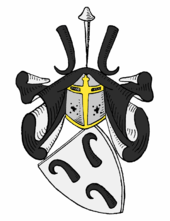
In the course of the state expansion of the Margraviate of Brandenburg , founded by Albrecht the Bear in 1157 , the Ascanian margraves secured what was then the only Bäke crossing with a castle. The Ascanian castle, which was possibly a wooden structure, was followed at the same place by the late medieval Machnow castle, which together with the Kleinmachnow estate remained in the possession of the von Hake family for centuries . Until 1470 there was only one crossing in the extensive Bäke swamp area. The Knüppeldamm was located at the medieval castle and formed a strategically important point on the Leipzig - Saarmund - Spandau trade route . Only when the Brandenburg electors moved their residence from Spandau to Berlin in 1470, two more Bäke crossings were added. Kleinmachnow was first mentioned in a document in 1375 in the land book of Charles IV under the name Parvamachenow (Parva = small).
At that time, the von Löwenberg family and the mint master Thile Bruges owned the small Brandenburg village, after which the von Quast family . Around 1435 the feudal ownership of the Kleinmachnow and Stahnsdorf estates passed to the von Hake family , after their most famous offspring, the "long hoe" of the soldier king , General Hans Christoph Friedrich von Hacke (1699–1754), the Hacke'sche Markt in Berlin- Middle is named. To the right of Kleinmachnower Dorfstrasse, behind the Medusa portal , was the manor with the old castle, of which only remains of the foundation walls have been preserved. Immediately next to Machnow Castle, the Hakes had David Gilly build a new mansion in the classicist Baroque style in 1803 , which had a richly furnished ballroom and rooms with Parisian wallpaper , similar to the Gilly castles Paretz and Freienwalde . In 1943 both the Gilly'sche Herrenhaus and the Alte Hakeburg burned out and were demolished in 1950.
After a property division Dietloff had Hake in 1908 on the Seeberg at the opposite northern shore of Lake Machnower the so-called New Hakeburg by Bodo Ebhardt build. It remained in the family until 1936, the main property until the expropriation in 1945. It is the only one of the Machnow mansions that is still standing.
"Medusa portal" to Gut Kleinmachnow with Machnow Castle
Kleinmachnow mansion (by David Gilly , 1803)
New Hakeburg in Kleinmachnow, built in 1908
See also: Gutshof Machnow and history of Kleinmachnow .
Modern times until 1945
The official spelling of the municipality was Klein Machnow in 1816 and Klein-Machnow in 1828 . The estate remained in the possession of the von Hake family until 1945 , who, however, sold large parts of their estate as building land due to the settlement at the beginning of the 20th century . The village south of the Machnower See was an ensemble of the old Hakeburg , which no longer exists today , an equally demolished castle or mansion , the Medusa portal , which is now a listed building , the Kleinmachnower village church , the Bäkemühle and some residential buildings. From 1906 to 1908 the New Hakeburg was built on the Seeberg north of Lake Machnower .
The construction of the Teltow Canal from 1901 to 1906 and the Kleinmachnow lock represented the turning point in the development of the village. The lock was a major attraction and attracted many Berlin day trippers to the nearby inns on the weekends. After the city of Berlin expanded rapidly at the end of the 19th and beginning of the 20th century, Kleinmachnow moved into the focus of development companies. The old Zehlendorfer villa colony was built between 1906 and 1910 . The First World War drove the construction companies into liquidation.
Because of the good rail connection between Dreilinden station and downtown Berlin, at the time the intersection of the main line that was inaugurated in 1838 and the cemetery line that opened in 1913 , Berliners settled near the station. The Dreilinden colony was created, which was later to become the district of Kleinmachnow.
At the end of the twenties and early thirties Kleinmachnow was opened up to the west. In contrast to the villa colony, the focus was now on affordable land and house purchase for medium-sized families. The building contractor Adolf Sommerfeld opened up new settlement areas with standardized single-family houses in an almost industrial construction. Even today, these houses form the town house settlement , large parts of Kleinmachnower appearance. Sommerfeld also planned an underground connection to his settlement and on to the Machnower lock. He had already promoted today's underground line 3 to Krumme Lanke politically and financially and wanted to push through the construction of the BVG , but was forced to leave Germany in 1933 due to his Jewish religion. To this day, the route clearance for the planned subway construction on Karl-Marx-Straße and Hohe Kiefer is clearly visible.
The von Hake family sold the Hakeburg to the Reichspost in 1937 because of financial difficulties . Reichspostminister Wilhelm Ohnesorge made the castle his private residence. Since Hitler came to power in 1933 , Ohnesorge had been State Secretary , with membership number 42 " old fighters " of the NSDAP and holder of the Golden Party Badge . He set up a research institute that dealt with issues of importance to the war effort.
The armaments company Dreilinden Maschinenbau GmbH (DLMG), a wholly owned subsidiary of Bosch created in 1935 , provided u. a. Injection pumps and other aircraft engines are produced for Daimler-Benz Motoren GmbH in neighboring Genshagen . On the DLMG grounds was the concentration camp Kleinmachnow, have worked in which up to 5,000 people, of which about 2,700 prisoners of war , forced laborers and concentration camp prisoners. About 800 Poles were arrested during the Warsaw Uprising of 1944 and transferred to the camp. Towards the end of the war, all prisoners were transferred to the Sachsenhausen concentration camp and driven from there on the notorious death march . A memorial commemorates the labor camp and the history of the place.
During the Second World War, the first bombs fell on Kleinmachnow in the spring of 1943. During 1943 bombing raids destroyed the manor, the old Hakeburg and large parts of the old village center, the lock and the new Hakeburg remained almost intact.
Division and GDR period
In June 1946 the Reichspost was expropriated and the SED new owners of the Hakeburg . Between 1948 and 1954, the SED's “Karl Marx” party college was located on the site . The Hakeburg developed into the ideological center of the GDR . In 1973/74 the Central Committee of the SED also set up a central special school in the Hakeburg. The focus was on the further training of leading cadres for agitation, propaganda and culture and the qualification of party school teachers. In 1979 the Hakeburg was refurbished and in 1980 it was converted into a guest house for state guests.
In September 1952 the GDR regime imposed considerable traffic restrictions due to the proximity to the border and massively reduced the crossing to West Berlin via the Düppel border crossing. About 2000 Kleinmachnower protested against this in a community meeting on October 30th. In a resolution by citizens to the GDR Prime Minister Otto Grotewohl , the withdrawal of the measures and the naming of those responsible were called for. On the instructions of the SED, nine of the signatories were indicted and sentenced in a political show trial as “pests and saboteurs” to a total of 46 years in prison, and their property was expropriated. The authoritarian regime in the Soviet occupation zone and later GDR against the background of the Cold War led to a considerable loss of population through displacement until 1961.
After the Berlin Wall was built in 1961, the greater part of the Kleinmachnow district boundary formed the border to West Berlin; That is why only party members who were loyal to the line were allowed to move to Kleinmachnow, of whom the regime assumed that they were not planning to flee the GDR , and the residential buildings on the border were only accessible under strict access restrictions. With the construction of the wall, Dreilinden was separated from Berlin-Wannsee and became part of Kleinmachnow. In 1969, the original route of the autobahn, which was built in 1940, was redrawn because of the border line.
In today's Dreilinden district , the Drewitz border crossing point was enclave-like and militarily secured, and the Allied crossing Checkpoint Bravo between West Berlin and the GDR on today's Autobahn 115 . The border regiment 42 "Fritz Perlitz" was stationed in Kleinmachnow and for decades prevented numerous people from crossing the border by force. When trying to get from the GDR or East Berlin over the Wall to West Berlin , over 120 people lost their lives until the fall of the Wall in 1989. These included four victims of the Wall in Kleinmachnow . At Adam-Kuckhoff-Platz, today's weekly market, a memorial stone commemorates the victims of the German division.
After 1990
From 1990 the principle of return before compensation was applied by the then federal government. More than half of the apartments and properties were under compulsory government administration , which was the norm in the GDR for so-called western properties. The dispute between the owners, who were getting the rights to their land and houses back, and the tenants made headlines in the early 1990s. In 1990, the first tenants 'union in Brandenburg and the citizens' movement and party Kleinmachnow Citizens against Expulsion were founded in Kleinmachnow , which received 25 percent of the vote in 1994. The development of a building area south of Stolper Weg and the discounted surrender of the building land to Alt-Kleinmachnower defused the heated atmosphere.
From the mid-1990s onwards, numerous new shops opened across the town: in 1993 the Fuchsbau-Eck; 1995 the new building complex at Uhlenhorst; 1996 the weekly market on Adam-Kuckhoff-Platz, the former checkpoint Düppel ; 1997 the residential and business complex on OdF-Platz and in 2002 new shops on Meiereifeld / Thomas-Müntzer-Damm. With the construction of a new town hall with residential and commercial buildings on Förster-Funke-Allee, the town hall market was created in April 2004, which is a new center of the town and a sign of the will to modern construction. The standard land value at the beginning of 2013 was between 210 and 300 euros per square meter. Kleinmachnow is characterized by the high proportion of around 75 percent single-family houses and 16 percent two-family houses.
A legal dispute has been going on since 1997 about the ownership structure of around 1,000 pieces of land in the Sommerfeld estate, which is one of the largest property law cases in Germany. In 1927, Adolf Sommerfeld , a Jewish building contractor, founded a settlement company. In April 1933 he fled Germany because of an attack by National Socialists, and his company was "Aryanized" . The Jewish Claims Conference sued against the return of the company in 1950 without the land and later sold the claims to the Berlin lawyer Christian Meyer because of the supposedly low chances of success. This led several legal proceedings and was able to achieve a transfer back or out of court agreements in individual cases. The property is said to have a market value of around 45 million euros. In 2006, the Federal Administrative Court approved an appeal against an administrative court judgment in one case, but not in another. In 2007 the Federal Administrative Court refused a transfer back because the later owners had not bought the houses from the private person Sommerfeld, but from the settlement company at a normal price. One at the Federal Constitutional Court led constitutional complaint was not adopted in September 2009 for decision.
Population development
Until the First World War, the character of a manor village at the gates of Berlin was largely preserved. The population was below 450 inhabitants. As a result of the settlement in Dreilinden and in the north-east and, in particular, as a result of the establishment of the town house settlement by Adolf Sommerfeld in the north-west, the population jumped from 944 in 1926 to 5,900 in 1935 and to 12,565 in 1939.
The considerable loss of population caused by fleeing to the Federal Republic of Germany up to 1961 was offset by the influx of new citizens. After reunification, the population remained at a constant level until 1996. Due to the increased clarification of return claims from previous owners and the attractive location of Kleinmachnow, there has been a population increase of around 75 percent from the mid-1990s until today. In addition to the residents with their main residence, around 800 people with secondary residence are also registered.
The development of the population is characterized by the strong immigration of young families. Around a sixth of the population are under 12 years old. This makes Kleinmachnow one of the most child-rich communities in Brandenburg.
|
|
|
|
Territory of the respective year, number of inhabitants as of December 31 (from 1991), from 2011 based on the 2011 census
religion
In 1539 the Elector of Brandenburg Joachim II introduced the Reformation . After that, Brandenburg was a predominantly Protestant region for centuries. The Lutheran creed was predominant alongside the Reformed Church . The von Hake family renounced their Catholic faith in 1539 before the Elector.
The old village church was completed in 1597 as one of the first Protestant church buildings in the Mark Brandenburg. It was initially owned by the von Hake family . When Kleinmachnow expanded in the 1920s and 1930s, a parish hall was built in Jägerstieg , which was expanded to become the Church of the Resurrection in 1953 . The Evangelical Resurrection Church Congregation has grown considerably and now has around 5,400 members (as of August 2012).
In addition to the regional church community, there was the Evangelical Lutheran Free Church in the former seaman's recreation home on Zehlendorfer Damm with around 70 members since 1922 . It was founded in 1871 and has been called the Paul Gerhardt Congregation of the Evangelical Lutheran Free Church since May 2007 . With the sale of the property to the rapper Bushido , the congregation stopped the local church services. The pastor responsible for Brandenburg continues to live in Kleinmachnow, the services have been moved to Teltow.
With the construction of the Teltow Canal, many workers came from Catholic regions of the German Empire , especially from Upper Silesia . So after 350 years of interruption, a new Catholic parish came into being. It received its first organization in the workers' association founded in 1905 . 15 years passed until the first emergency church in Teltow was completed in 1920. The first Holy Mass was held for Kleinmachnow and Stahnsdorf in the Kleinmachnow lock restaurant in 1935 . In 1948 the emergency church St. Thomas More was completed and in 1960 Kleinmachnow was raised to a parish . The present church on the Hohen Kiefer was consecrated in 1992. Since 2003 the Catholics of the region in Stahnsdorf, Kleinmachnow, Teltow and Großbeeren belong to the congregation Sanctissima Eucharistia with the churches St. Thomas More in Kleinmachnow and Ss. Eucharist in Teltow.
There are hardly any other religions. The Christian Science Community is represented in Kleinmachnow with one of 80 congregations in Germany. She celebrates church services in the Engelbert Humperdinck music school on the vineyard. There is no Muslim or Jewish community in Kleinmachnow.
politics
Community representation
The community council of Kleinmachnow consists of 28 community representatives and the full-time mayor.
| Party / group of voters | Seats
2014 |
Seats
2019 |
|---|---|---|
| Alliance 90 / The Greens | 5 | 7th |
| CDU | 7th | 5 |
| SPD | 6th | 5 |
| Citizens for a good quality of life in Kleinmachnow e. V. | 2 | 3 |
| The left | 3 | 3 |
| FDP | 1 | 2 |
| AfD | 1 | 2 |
| PRO Kleinmachnow | 1 | 1 |
| Individual applicant Viktoria Brammer | 1 | - |
| Pirate party | 1 | - |
Until 2003, the long-established Kleinmachnow had the political say in the village: This led to a strong PDS vote until 2003 , because the GDR regime, due to the proximity to West Berlin, had targeted people loyal to the regime in Kleinmachnow who were not "escaped from the republic" feared. In the election in October 2003, the numerous newly arrived residents were responsible for more than 50% of the election of the members of the municipal council for the first time: The significant influx of people in the village influenced the political orientation; Unlike in parts of Brandenburg, Bündnis 90 / Die Grünen were able to move into parliament, while Die Linke (formerly PDS) lost its influence. The CDU was roughly on par with the SPD , which has been the mayor since 1990.
The composition of the representation changed with the local elections in May 2014. The CDU was again able to assert itself as the strongest force before the SPD. Bündnis 90 / Die Grünen replaces Die Linke as the third strongest political force in the municipal council and has recorded the greatest percentage gain of all parties. The left now follows with the fourth strongest result, ahead of the non-party group BIK, which slightly increased its share of the vote. The FDP lost a percentage and is now represented with one seat in the municipal council. The AfD and the pirates have each moved in with one seat. Further voter initiatives are Pro Kleinmachnow and the individual applicant Viktoria Brammer, each with one seat.
Because of his Stasi past, Klaus Nitzsche lost the trust of the municipal council in 2009 and was voted out of office as its chairman.
mayor
- 1945–1946 - Ernst Lemmer (CDU)
- 1961–1962 - Antonie Stemmler (SED)
- 1990–1994 - Klaus Nitzsche (SPD)
- 1994-2009 - Wolfgang Blasig (SPD), withdrawal due to election as district administrator of the district of Potsdam-Mittelmark
- since 2009 - Michael Grubert (SPD)
In the mayoral election on November 27, 2016, Grubert was elected for a further term of eight years with 57.8% of the valid votes.
Cooperation with neighboring communities
A merger of the communities of Kleinmachnow, Stahnsdorf and Teltow was already being considered in 1967 in the GDR . From 1972 onwards, the region formed a municipal association in terms of administrative organization , in which the three municipalities retained their legal independence. The discussion about the appropriate functional structure has been ongoing since German reunification in 1990. The spectrum of opinions fluctuates between informal cooperation, contractually agreed cooperation and merger to form a large community . Kleinmachnow remained unaffected by the municipal area reform carried out in Brandenburg between 2000 and 2003 .
The discussion is stimulated by the adoption of the Berlin-Brandenburg State Development Plan 2009, which provides for a new two-tier system of central locations for Brandenburg with four regional centers and 50 medium-sized centers. Of the three communities, the development plan only identifies Teltow as a medium-sized center, which means reduced funding for Stahnsdorf and Kleinmachnow. There is no discernible result of the political discussion that has been going on for years.
The municipalities of Kleinmachnow, Teltow and Stahnsdorf founded the municipal working group Der Teltow (KAT) in 1999 . This is intended to deepen the cross-community cooperation in the areas of spatial development planning, transport and administrative activities as well as in social, health, cultural, school and sports facilities. In fundamental and structural terms, the KAT has not yet been able to shape the region. Since April 2013, the three municipalities have been shareholders of the Freibad Kiebitzberge GmbH , which operates the open-air swimming pool in the Kleinmachnow area.
The Teltow Canal forms the border between the communities of Kleinmachnow, Stahnsdorf and Teltow as well as Berlin and Potsdam. So far, it has not been used for local recreation, leisure and water sports. The interest group Teltowkanalaue is aiming for the creation of new continuous hiking and biking trails between the S-Bahn station Teltow-Stadt and the Potsdam S-Bahn station Griebnitzsee . The creation of an inter-communal green corridor is intended to overcome communal boundaries and to strengthen regional cooperation between the three communes. The Teltow Canal floodplain is an integral part of the TeltowPark regional park, which spans space .
coat of arms
The President of the Province of Brandenburg awarded the municipality the coat of arms on February 6, 1937. Attempts by the National Socialists to change the coat of arms failed. They wanted to put a swastika in the free space between the two lock gates . The coat of arms was confirmed on January 7, 1994. The coat of arms was redesigned by the heraldist Frank Diemar .
Blazon : “Divided by blue and silver, on top a silver lock building with red roofs with three black lock gates, the middle one raised; below three black wall hooks , the left one facing the other way. ”In the upper part it shows the gate of the lock Kleinmachnow, in the lower part the three gemshorns (hooks) from the coat of arms of those of Hake.
Parish partnership
Kleinmachnow has had a partnership with the town of Schopfheim in Baden-Württemberg since 1996 . The roots of this partnership are based on the contacts of the Protestant churches in both places since 1948. This connection also lasted during the times of German division. In 1971, two groups from the parishes in East Berlin met for the first time.
As a gift from the Schopfheimers for the ten-year anniversary of the partnership in June 2006, a milestone with a coat of arms and distance information adorns the entrance to the Rathausmarkt.
Sights and culture
In the list of architectural monuments in Kleinmachnow and in the list of ground monuments in Kleinmachnow are the cultural monuments entered in the list of monuments of the state of Brandenburg.
Buildings
At the course of the Bäke, south of the Machnower See, there are numerous buildings whose history is connected to the von Hake family: the Medusentor to the former Hake'schen Gutshof , the Bäkemühle , the village church and the old forester's house. The new Hakeburg , designed by the architect Bodo Ebhardt , is located on the Seeberg on the north bank of Lake Machnower . It offers a panoramic view of the lake and the Bäketal.
The Teltow Canal is an artificial waterway 37 kilometers long and connects the Havel near Potsdam with the Dahme in Berlin-Grünau . The Kleinmachnow lock is located west of Lake Machnower , through which the Teltow Canal flows . The old lock bridge, badly damaged by a barge in 1993, was replaced by a new one in 2005.
The Weinbergviertel with three streets is next to the old village center with the village church. Several houses in the district are listed buildings, including the house built by Egon Eiermann around 1936 for the actor Paul Henckels and the country villa built in 1906 by master bricklayer Fritz Schirmer for the village school teacher Koch. The citizens' initiative Weinberg sind Wir , founded in 2005 , campaigns for the preservation of natural stone paving on streets and sidewalks. In January 2006, the Brandenburg State Monuments Office placed the entire road system in the Weinberg district under protection and entered it on the state's list of monuments.
Magnificent villas such as Villa Elisabeth and Villa Medon bear witness to the early country house buildings in the old Zehlendorf villa colony . The Villa Medon was built in 1906 according to plans by the Berlin architect Max Welsch. The builder was court fountain builder Gustav Georg Medon (1859–1913), son of the Berlin royal dancer and dance teacher Gustav Medon (1823–1905).
On Autobahn 115 , in the immediate vicinity of the former GDR border and in front of the former Drewitz border crossing point, there is a stele ( photo ) bearing the GDR national coat of arms. Shortly afterwards, coming from Berlin, there is a concrete base on the left behind a noise protection wall, which supports a pink snow blower ( photo ). Until the reunification, a Soviet tank (T34) stood on the base as a symbol of victory for the Red Army over the Third Reich . The commandant's tower and parts of the handling building have been preserved from the former border crossing point in the Dreilinden district. The association CHECKPOINT BRAVO e. V. supports the restoration, expansion and maintenance of the listed tower. The tower was completely renovated in 2007 and contains a permanent exhibition that recalls the history of the division of Germany.
Nature and natural monuments
Kleinmachnow is a "residential community in the countryside". The share of residential areas in the community area is 45%. 40% of the area is available as a forest, sports, green, water or biotope area for recreation. The proportion of roads, commercial and special areas is comparatively small at 15%. The will of many citizens to preserve the green character of the community found its expression from 1990 onwards in the protection of the ban forest , the Kiebitzberge , the Buschgraben and the Bäketal . It is also expressed in the strict forest protection statute , the norm control action directed against it was dismissed.
On the former border strip in the far east of Kleinmachnow lies the Buschgraben with Buschgrabensee and the wetland on Erlenweg. The Buschgrabensee, created in 1926, was cut from peat after the Second World War and later served as a rainwater retention basin. The wetland on Erlenweg is a silted-up channel lake . Since both areas were not accessible between 1961 and 1990 due to the border installations, nature was able to develop undisturbed. An abundance of plant species and over 70 species of birds were able to develop. 259 species of butterflies live here, and over 300 species of plants have been identified.
The meadows in the landscape protection area at the Weinberg are a source area of the Bäke. On its course of around three kilometers through the Bäketal Kleinmachnow , this section of the river gains a considerable volume of water, which allows a flowing stream to form all year round. Since the course of the Teltow Canal has been straightened through the Machnower See , this part of the Bäketal has been preserved almost in its original position and, with parts of its original vegetation such as swampy wet meadows and alluvial forests, has been designated as a Bäketal nature reserve. 87 bird species were counted. 59 species breed, 11 of which are particularly worthy of protection.
In this area, the four oldest oaks Kleinmachnow, at 600 and 700 years old, as well as a nature trail laid out in 2004 by the Local Agenda 21 stand as natural historical monuments . The Local Agenda 21 is a program of action that the community should develop towards sustainability . In November 2000, Kleinmachnow published its mission statement for sustainable, environmentally friendly development. The working group for hiking trails has marked six hiking routes since 1997. These are the Buschgrabenrundweg, the Bannwaldweg, the Dreilinden forest path, the hiking trail around Lake Machnower and the supraregional routes Bugaweg 2001 and Fontaneweg .
The Bannwald is a wooded green corridor that runs through Kleinmachnow in an east-west direction. It is around three kilometers long, 50 to 100 meters wide and offers a varied flora and fauna in different parts of the forest.
In the Bäketal near the forester's house there is an oak with a chest height of 7.63 m (2016).
Historical monuments
Nordahl Grieg died on December 2, 1943 in the attack on Berlin when the Lancaster LM 316 was shot down, in which he was a war correspondent. The crash site is on the shores of Lake Machnower . At the request of the Norwegian embassy, the Kleinmachnow community erected a boulder there as a memorial. At the inauguration of the memorial on November 23, 2003, the Norwegian singer Torhild Ostad sang the song Til Ungdommen .
Around 1950, a memorial stone was placed on the square of the same name (OdF-Platz) at the confluence of Karl-Marx-Strasse for the victims of fascism . The boulder shows the prisoner's corner with the letters "KZ". Underneath the inscription "THE DEAD / FOR HONOR / THE LIVING / FOR ADMINISTRATION". The mayor of the community commemorates the Nazi crimes with a wreath-laying ceremony there on January 27, the day of commemoration of the victims of National Socialism. The victims of the Second World War are commemorated annually on May 8, the end of the war in Europe, at the Soviet memorial in the Hohe Kiefer .
Art and music
From a cultural point of view, the Kammerspiele , founded in 1938, formed a central meeting point for cinema, theater and society, but also as a meeting room for the council of the community. The house was operated by the state or municipalities from 1960 to 2003 and has been privately owned as a cinema since 2004. After the ten-year lease had expired, the use of the Kammerspiele as the community's cultural center was discussed and the mayor was commissioned to negotiate the purchase at the end of 2005. An agreement could not be reached. The Friends of the Kulturhaus Kammerspiele e. V. disbanded in September 2006. In November 2012, the first cultural cooperative in Brandenburg took over the business as a new tenant and renamed the theater to Die Neue Kammerspiele . In addition to the cinema, various cultural events and a children's program are on the agenda.
From 1986 training on wind instruments took place in the Kammerspiele. In 1992 the association Jugendblasorchester Kleinmachnow e. V. founded. This was dissolved in 1995 and transferred to the Engelbert Humperdinck district music school in the Potsdam-Mittelmark district. The name of the youth wind orchestra Kleinmachnow was retained. In 2005, the District School of Music and the District Adult Education Center merged and continue their work as the District Music School and the District Adult Education Center Potsdam-Mittelmark GmbH , based in Kleinmachnow.
The non-profit culture and art association Kleinmachnow e. V. has its seat at Zehlendorfer Damm 45–47. Due to fire protection deficiencies, no events have been allowed to take place in the former Joliot Curie Club since July 2006. The events are now taking place in different locations.
In 1997, next to the neighboring Zehlendorfer Teltow shipyard, the Augustinum residential building of the foundation of the same name opened as a residence for 280 senior citizens. The building complex with 268 apartments includes a theater hall with 245 seats. With the largely public art and cultural offerings, the Augustinum is an established address for concert and theater fans from the region.
In 2005 employees of the former company equipment and control plants founded the association Industriemuseum Region Teltow e. V. This preserves the memory of the former companies and the industrial development of the region and has been in the neighboring town of Teltow since 2012.
Sonat-Verlag has been based in Kleinmachnow since 2013. It was founded in 2000, initially as a Berlin choral music publisher, by musician and publisher Stefan Rauh and publishes works for vocal and instrumental music.
Sports
The Kiebitzberge are the regional sports and recreation area with an outdoor pool, sports facilities, toboggan hill and forest. The regional SV Eintracht Teltow-Kleinmachnow-Stahnsdorf 1949 e. V. is the association with the largest number of members in the Potsdam-Mittelmark district, with around 2,700 members in twelve departments. The club's top-performing team plays basketball in the 2nd Bundesliga .
In addition, more than a dozen other clubs offer various sports. The sports facilities are either in Kleinmachnow or in the neighboring Teltow, Stahnsdorf or in nearby Berlin districts. The largest privately operated sports facility in Kleinmachnow is the Sportpark Kleinmachnow in the Kiebitz Mountains, formerly Sportforum Kleinmachnow .
The Eigenherd Europaschule Kleinmachnow was named the sportiest school in Brandenburg in 2001 and 2007 by the Ministry of Education, Youth and Sport.
Regular events
The Augustinum Seniorenstift with its theater hall is a frequently used place for lectures, readings and music events. The AWO meeting point and the Toni Stemmler leisure center have regular offers for senior citizens, and the JFE youth leisure facility for young people . Those interested in music can choose between the church choir of the village church or the monthly meeting of the house music group in the district music school. For children there has been the Kleinmachnow Children's Festival on the Rathausmarkt since 2006 and the Kleinmachnow Fairy Tale Days since 1990 between the end of October and mid-November .
Economy and Infrastructure

The 45-hectare Europarc Dreilinden industrial park with Kleinmachnow's largest employer, the German eBay headquarters, has been located on the site of the former Drewitz border crossing point . The operator of the Internet marketplace, which has been located in Kleinmachnow since 2000, increased its workforce by 600 to 1,300 between 2004 and 2008. Due to a later outsourcing of international customer care to Dublin and the cancellation of 400 jobs, 900 employees are still working for eBay in Kleinmachnow. A total of around 3,000 people are employed in 80 companies in the technology and business park. The development in the 25 hectare fashion park on Fahrenheitstrasse, which was originally intended to be a center for the textile and fashion industry, is not so positive . The plan failed years ago. In June 2006 the municipality changed the name to TIW area (technology, innovation, science) . Around 1,530 businesses, mostly small businesses and sole traders, are registered in the municipality. Of these, a good 200 have to pay trade tax in advance.
Public facilities
At City Hall on Adolf Grimme ring are the administration of the municipality, the seat of the mayor , the city office , public library and the self-propelled Kita-composite that all municipal daycare operates. Events with up to 300 visitors can take place in the foyer. The meeting room of the community representatives offers space for events up to 200 people.
With the youth leisure facility CARAT - youth work Kleinmachnow , the community has been offering young people between the ages of 12 and 21 years of age. The regular program includes music workshops, creative courses, dance groups and graffiti courses. In addition, a school café opens in August 2013 in Hohen Kiefer, which is to be replaced at a later date by a permanent youth center at another location. In 1991, the self-owned building yard was founded as a further municipal facility , which is responsible for the maintenance of green spaces and winter road maintenance .
The Julius Kühn Institute - Federal Research Institute for Cultivated Plants , which emerged from the Federal Biological Research Center for Agriculture and Forestry on January 1, 2008 , is a research institution in the portfolio of the Federal Ministry of Food, Agriculture and Consumer Protection . The Institute for Strategies and Impact Assessment in Plant Protection is located in Kleinmachnow .
In order to guarantee the correctness of measurements, there were separate state authorities in Berlin and Brandenburg . These were merged in 2005 and today form the Berlin-Brandenburg State Office for Metrology and Calibration, based in Kleinmachnow .
In the state of Brandenburg everyone has the right to inspect files in accordance with the File Inspection and Information Access Act. The state commissioner for data protection and the right to inspect files , based on Stahnsdorfer Damm, is a supervisory body for compliance with data protection and freedom of information at public bodies. He is not responsible for inspecting "Stasi files". These documents are administered by the Federal Commissioner for the Records of the State Security Service of the former GDR .
traffic
Road traffic
Kleinmachnow is on the federal motorway 115 (junction 5 Kleinmachnow ). The A 115 connects the Berliner Stadtring (A 100) in the southwest of Berlin with the southern Berliner Ring (A 10). Landesstraße 40 runs close to the southern boundary of Kleinmachnow . It opens up the southern Berlin area via Stahnsdorf, Teltow, Mahlow and Schönefeld to Berlin Treptow-Köpenick . It connects Kleinmachnow with the federal highways 101 , 96 and 179 . The distance to Berlin-Tegel Airport is less than 25 kilometers, to Berlin-Schönefeld Airport less than 30 kilometers.
Local public transport is served by five bus routes operated by Regiobus Potsdam-Mittelmark GmbH. All lines are to be used in tariff zones Berlin C or Potsdam C of the transport association Berlin-Brandenburg . The bus lines connect Kleinmachnow with the S-Bahn stations Teltow Stadt (bus 620, connection to the S-Bahn line S25 ), Mexikoplatz (bus 622, connection S1), Berlin-Wannsee (bus 620, connection S1 / S7), Berlin- Zehlendorf (bus 623, connection S1) and the underground stations Krumme Lanke (bus 622, connection U3) and Oskar-Helene-Heim (bus 623, connection U3). Bus lines 628 (on- call bus ) and 629 also operate in Kleinmachnow. With the exception of line 628, all lines run every 20 minutes on weekdays.
The Berlin-Schoenefeld Airport can be reached by bus (with change) and by car within 45 minutes.
Rail transport
The Berlin-Wannsee train station offers connections to long-distance traffic , several regional express lines and regional trains . From the Kleinmachnow town hall market, the Berlin train stations Potsdamer Platz and Zoologischer Garten can be reached in around 45 minutes.
On the northern edge of Kleinmachnow the former route of the Berlin-Potsdamer Eisenbahn ( main line ) runs along, on which there has been no rail traffic between Düppel and Griebnitzsee since 1945. The trunk line led before the Second World War Griebnitzsee and Babelsberg to Potsdam . In the Dreilinden district, it crossed the cemetery railway . This led from Berlin-Wannsee to Stahnsdorf to the cemeteries of Berlin parishes. With regard to a better connection to the Europarc Dreilinden industrial park , various alternatives for resuming regional or S-Bahn traffic were discussed. The Verkehrsverbund Berlin-Brandenburg rejects an extension of the S25 S-Bahn line from Teltow to Kleinmachnow.
Shipping
The traffic project German Unity No. 17 (federal waterway connection Hanover-Magdeburg-Berlin) aimed to make the Teltow Canal navigable according to inland waterway classification Vb for large motor cargo ships up to 110 meters in length and push convoys up to 185 meters in length. Various environmental associations have protested since 1992 against the expansion of the lock because of the feared massive interference in the riverbank landscape. Until the end of 2010, the Federal Ministry of Transport adhered to the plan approval decision, which provided for an extension of the northern chamber of the lock to a length of 190 meters. On November 19, 2010, the expansion of the lock was stopped by a decision by the Federal Minister of Transport, Peter Ramsauer . Instead, a refurbishment of the lock is planned. A lawsuit to expand the lock failed in January 2013 before the Potsdam Administrative Court.
education
All municipal day-care centers , eight combined crèches and kindergartens as well as three after -school care centers with a total of 1200 places, are operated by the KITA association . In addition, with the Protestant and Catholic kindergarten, the Waldorf kindergarten and the English Klax kindergarten there are five independent day-care centers.
In Kleinmachnow there are three communal primary schools: the Steinweg primary school (430 students), the primary school on the Seeberg (260 students) and the Eigenherd-Europa-Schule (470 students). The Evangelical Primary School Kleinmachnow, founded in 2004, is a Christian-oriented all-day school run by the Hoffbauer Foundation . As a secondary school, around 600 students attend the Maxim-Gorki Comprehensive School with an upper level. In 1991 the Weinberg-Gymnasium Kleinmachnow emerged from the Extended Special High School Kleinmachnow . Today, around 780 students are given special support there in the fields of mathematics and science. The education landscape by the Free supplemented Waldorf School , the General Special Education and the school with special educational focus on "mental development" Albert Schweitzer. The Evangelical Gymnasium Kleinmachnow of the Hoffbauer Foundation has existed since 2008 .
The Berlin Brandenburg International School (BBIS) has existed on the Seeberg since 2001 as a private, English - speaking all-day school . Around 680 students from 58 different nationalities are taught. The non-profit organization, which runs the school, invested in the construction of a school campus with modern sports facilities after purchasing the area in 2006.
The Waterways and Shipping Directorate East has a vocational training center in the immediate vicinity of the lock . There are Wasserbauer and Verwaltungsfachangestellte trained.
Personalities
Honorary citizen
The only honorary citizen to date has been Heinrich Funke since 1932. From 1895 he was a forester at the Hake'schen Gutshof , later head of the estate. After the estate district was dissolved and changed into the Kleinmachnow community, he was the first community leader from 1920 to 1931.
Sons and daughters of the church
- Ernst Ludwig von Hacke (1651–1713), Prussian lieutenant general
- Gerhard Geidel (1925–2011), marine painter and illustrator
- Cornelia Behm (* 1951), politician ( Alliance 90 / The Greens )
- Stefan Kolditz (* 1956), writer , playwright
- Raphael Statt (* 1958), monk and sculptor
- Michael Heilmann (* 1961), former long-distance runner
- Tina Bara (* 1962), photographer , professor for artistic photography at the Leipzig University of Graphics and Book Art
- Jörg Huke (* 1962), jazz and theater musician
- Carsten Ohle (* 1968), handball goalkeeper
- Deborah Kaufmann (* 1970), actress
- Susanne Bormann (* 1979), actress
Personalities who lived or still live in the place
- Friedrich Kayssler (1874–1945), actor
- Wilhelm Conrad Gomoll (1877–1951), writer
- Paul Henckels (1885–1967), actor
- Johannes Arpe (1897–1962), actor
- Hubert Faensen (1928–2019), art historian
- Karla Runkehl (1930–1986), actress
- Horst Mahler (* 1936), lawyer, founding member of the Red Army parliamentary group
- Jörg Schönbohm (1937–2019), general and politician (CDU)
- Tuomo Hatakka (* 1956), CEO of Vattenfall GmbH
- Harald Effenberg (* 1957), actor
- Frank Lüdecke (* 1961), cabaret artist and director
- Stefan Rauh (* 1963), musician, head of the Sonat publishing house in Kleinmachnow
- Guido Beermann (* 1965), politician (CDU)
- Peter Christian Feigel (* 1966), conductor
- Monique Garbrecht-Enfeldt (* 1968), speed skater
- Tobias Schenke (* 1981), actor
- Philipp Walsleben (* 1987), professional cyclist
- Nelly Marie Bojahr (* 1988), Miss Germany 2007
Personalities who have worked on site

In 1909 Lily Braun , a women's rights activist who wrote, was one of the first to build a villa in Kleinmachnow. The composer and music theorist Arnold Schönberg was a guest in Ferdinand Lepcke's house of sculptors . In 1921 Schönberg developed the “method of composing with twelve only related notes”, which is known as twelve-tone music.
Kurt Weill , known as a composer for the Threepenny Opera by Bertolt Brecht , in 1931 bought a house in the Bauhaus style in the Kathe Kollwitz Street in Kleinmachnow. He moved in with his wife Lotte Lenya in March 1932. Lenya was an interpreter and propagandist of his works. After the seizure of power of the National Socialists both emigrated in 1933, first in the Switzerland .
The actor Paul Henckels starred in more than 230 films from 1923 to 1961. His role as Professor Bömmel in the film Die Feuerzangenbowle will not be forgotten . Shortly after moving into the Villa Am Weinberg 5, which was built in 1936, he gave it up because of hostility towards his Jewish wife. In April 1945, the state actor Friedrich Kayssler was accidentally shot by Soviet soldiers in front of his house.
Adolf Grimme , a social democratic cultural politician, lived in Kleinmachnow from 1930 until his arrest by the Gestapo in 1942 because of a connection to the so-called Red Orchestra . After the Second World War he became the first director of the newly founded Northwest German Broadcasting Corporation . The important Adolf Grimme Prize for television programs is named after him.
Various writers live or lived in Kleinmachnow or died there. These include Wolfgang Joho (1908–1991), Hanns Maaßen (1908–1983), a journalist and freelance writer, Walter Janka (1914–1994), a publisher who has lived in Kleinmachnow since the 1960s, and Friedo Lampe . Lampe was shot dead in 1945 by a Red Army soldier who mistook him for an SS man. The most important writers include Fred Wander (1916–2006) and his wife Maxie Wander (1933–1977), as well as the couple Christa Wolf (1929–2011) and Gerhard Wolf (born 1928). Paul Eipper , an author of numerous animal books, lived around 1939–1949 on Richard-Strauss-Weg 11. Heiner Rank (born 1931) writer.
Richard Groschopp and Karl Gass are considered two of the most renowned DEFA - directors . Written by Gerhard Bengsch the scripts for a plurality of DEFA movies and television films for the originate German broadcast television . He was a multiple award-winning writer who lived in Kleinmachnow from 1956 until his death in 2004. Konrad Petzold , who died in Kleinmachnow in 1999, was a director who directed numerous DEFA children's films and so-called " DEFA Indian films ".
Others
On October 7, 2005, the unissued Audrey Hepburn welfare brand was auctioned for the record price of 135,000 euros. The postmark of the left corner piece shows the posting post office KLEINMACHNOW 1 / b / 02/11/04 - 18/14532 .
literature
- Peter Hahn & Jürgen Stich: Teltow Canal - 80 stations & stories . With contributions to line 96, Gasthaus zur Schleuse, Schleuse Kleinmachnow, Schleusnerbude, Kleinmachnow harbor, Hakeburg, Kleinmachnow village church. Oase Verlag 2014. ISBN 978-3-88922-101-8 .
- Nicola Bröcker, Andreas Jüttemann, Celina Kress: 100 years of neighborhoods. In the metropolitan region: Kleinmachnow & Zehlendorf. Working group BJK Kleinmachnow-Zehlendorf u. a. Berlin 2011, ISBN 978-3-00-033521-1 , exhibition catalog.
- Nicola Bröcker: Kleinmachnow near Berlin. Living between town and country 1920–1945. Gebr. Mann, Berlin 2010, ISBN 978-3-7861-2629-4 .
- Nicola Bröcker, Celina Kress: Settle southwest. Kleinmachnow near Berlin - from a villa colony to a town house settlement. 2nd, revised and expanded edition. Lukas-Verlag für Kunst- und Geistesgeschichte, Berlin 2006, ISBN 3-936872-30-9 (1st edition 2004).
- Helfried Winzer: Gutsdorf Kleinmachnow 100 years ago. With village stories by Alfred Waßmund and postcards from the Wallberg collection. Edited by Nicola Bröcker. Lukas-Verlag for art and intellectual history, Berlin 2006, ISBN 3-936872-72-4 .
- Bertelsmann Stiftung (Ed.): Guide to Demographic Change 2020. Analyzes and action plans for cities and municipalities. Bertelsmann Stiftung Publishing House, Gütersloh 2006, ISBN 3-89204-875-4 .
- Bärbel Engel, Karl-Heinz Wallberg (Hrsg.): Kleinmachnow - pictures from old times. Magenow Verlag, Kleinmachnow 2003.
- Hubert Faensen : Keeper of secrets Hakeburg. Example of a change in function: mansion, ministerial residence, research institute, SED party school . Brandenburg State Center for Political Education, Potsdam 1997, ISBN 3-932502-00-0 ; Digitized version (PDF).
- Hubert Faensen: High tech for Hitler. The Hakeburg - from research center to management training center . Verlag Ch. Links, Berlin 2001, ISBN 3-86153-252-2 .
- Hubert Faensen, Bertram Faensen, Reinald Ellinger: The old church in Kleinmachnow. Parish Church Council of the Evangelical Resurrection Church Community in Kleinmachnow, Kleinmachnow 1997, ISBN 3-00-017417-6 .
- Heinz Koch: Chronicle of Kleinmachnow. 3. Edition. Haude & Spenersche Verlagbuchhandlung, Berlin 1997, ISBN 3-7759-0331-3 .
- Herbert Lange: Walks in Kleinmachnow (= Berlin reminiscences , volume 71). Haude & Spener, Berlin 1995, ISBN 3-7759-0395-X .
- Nicola Bröcker, Celina Kress: Settle southwest. Kleinmachnow near Berlin - from a villa colony to a town house settlement. Lukas-Verlag, Berlin 2004; 2nd, revised and expanded edition 2006, ISBN 3-936872-30-9 .
- Nicola Bröcker: Kleinmachnow near Berlin. Living between town and country 1920–1945 . Gebr. Mann, Berlin 2010, ISBN 978-3-7861-2629-4 .
- Peter Reichelt: Seen in place: Stories and history from Stahnsdorf - Kleinmachnow - Ruhlsdorf - Sputendorf - Schenkenhorst - GüterfeldeI . Self-published, 12/2018 ISBN 978-3-00-061381-4 .
Web links
References and comments
- ↑ Population in the State of Brandenburg according to municipalities, offices and municipalities not subject to official registration on December 31, 2019 (XLSX file; 223 KB) (updated official population figures) ( help on this ).
- ↑ German Meteorological Service: Mean precipitation levels 1961–1990 ( Memento from September 23, 2015 in the Internet Archive ) ( ZIP ; 349 kB)
- ↑ German Weather Service: Average sunshine duration 1961–1990 ( Memento from 23 September 2015 in the Internet Archive ) ( ZIP ; 42 kB)
- ^ Service portal of the state administration Brandenburg. Kleinmachnow community
- ^ Gerhard Schlimpert : The place names of the Teltow (= Reinhard E. Fischer (Hrsg.): Brandenburgisches Namenbuch Volume 3; = Berlin Contributions to Name Research 3). Hermann Böhlaus Nachf., Weimar 1972, ISBN 3-7400-0575-0 , p. 131.
- ↑ Official Gazette of the Royal Government of Potsdam, 1816, p. 410: Offer of the windmill in Klein Machnow for sale
- ^ Herbert Lange: Walks in Kleinmachnow . Haude & Spener, Berlin 1995, p. 116
- ↑ Andreas Jüttemann: The traffic-historical landscape around Dreilinden
- ↑ U3: U-Bahn extension to the Kleinmachnow lock www.berlin.bahninfo.de
- ↑ Keeper of secrets Hakeburg . ( Memento of the original from May 1, 2015 in the Internet Archive ) Info: The archive link was inserted automatically and has not yet been checked. Please check the original and archive link according to the instructions and then remove this notice. (PDF; 887 kB) Brandenburg State Center for Political Education
- ↑ Forced labor for Dreilinden Maschinenbau GmbH . Berlin history workshop
- ↑ Dreilinden. A concentration camp in Kleinmachnow . Berlin history workshop
- ↑ Kleinmachnow has a memorial for forced laborers since yesterday . In: Märkische Allgemeine Zeitung , September 2, 2006
- ↑ 50 years ago: Strike against speculators and saboteurs - the expulsion of homeowners from Kleinmachnow . ( Memento from January 31, 2008 in the Internet Archive ) Deutschlandradio Berlin, February 6, 2003
- ↑ Hartmut Häußermann , Birgit Glock, Carsten Keller: Working Paper No. 3, Winners and Losers in Kleinmachnow: The Perceptions of Restitution by Those Affected
- ↑ "Extremely Modern". Accessed December 30, 2018 .
- ↑ Page no longer available , search in web archives: Bodenrichtwerte Landkreis Potsdam-Mittelmark 2009–2012, February 11, 2013. (PDF; 146 kB) Expert committee for property values in the Potsdam-Mittelmark district
- ↑ Press release of the Administrative Court of Potsdam from April 8, 2003.
- ↑ Administrative Court Potsdam , decision of 10 April 2003, Az. 1 K 4239/98, decision of 17 February 2005, Az. 1 K 4241/98
- ↑ Heirs are allowed to keep Jewish properties. In: Berliner Zeitung , August 19, 2005.
- ↑ BVerwG: Decision of March 6, 2006, Az. 8 B 87.05, full text
- ↑ BVerwG: Decision of February 28, 2006, Az. 8 B 89.05, full text
- ↑ BVerwG: Decision of June 21, 2007, Az. 8 C 9.06, press release
- ↑ BVerfG, decision of September 16, 2009 , Az. 1 BvR 2275/07, full text.
- ^ Historical municipality register of the State of Brandenburg 1875 to 2005. Landkreis Potsdam-Mittelmark (PDF) pp. 18–21
- ↑ Population in the state of Brandenburg from 1991 to 2017 according to independent cities, districts and municipalities , Table 7
- ^ Office for Statistics Berlin-Brandenburg (Ed.): Statistical report AI 7, A II 3, A III 3. Population development and population status in the state of Brandenburg (respective editions of the month of December)
- ↑ Quiet in the rapper house . In: Märkische Allgemeine Zeitung , April 4, 2012.
- ^ Homepage of the Paul Gerhardt congregation
- ^ Parish chronicle . ( Memento of October 21, 2013 in the Internet Archive ) Parish Church of Sanctissima Eucharistia
- ^ Result of the local elections on May 25, 2014
- ↑ Result of the local elections on May 26, 2019. Accessed on July 24, 2019 .
- ↑ Result of local elections 2003, Kleinmachnow municipality
- ^ New Stasi allegations against Klaus Nitzsche . In: Potsdam Latest News , February 27, 2009 (accessed May 12, 2013)
- ↑ Brandenburg Local Election Act, Section 74
- ^ Result of the mayoral election on November 27, 2016
- ↑ State Development Plan Berlin-Brandenburg, March 31, 2009 ( Memento from January 19, 2016 in the Internet Archive ) (PDF; 4.1 MB) Joint state planning department of the states of Berlin and Brandenburg
- ↑ No motivation to work together . In: Potsdam Latest News , September 5, 2006.
- ↑ Flyer of the Teltowkanalaue interest group (PDF; 2.3 MB)
- ↑ Graphic Teltowpark. Landschaftspflegeverein Mittelbrandenburg e. V. / Regional Marketing Association "Der Teltow" e. V.
- ↑ Coat of arms information on the service portal of the state administration of Brandenburg
- ↑ List of monuments December 31, 2006 (PDF) Brandenburg State Office for Monument Preservation and State Archaeological Museum
- ↑ Peter Boeger; Monument with value in dispute. On the history of the tank memorial near Kleinmachnow . In: Brandenburgische Denkmalpflege 18, 2009, 2, pp. 88–98.
- ↑ Wood protection statute (PDF; 227 kB) Kleinmachnow municipality
- ↑ OVG Berlin-Brandenburg, judgment of February 10, 2011 , Az. 11 A 1/08, full text
- ↑ The bush trench . ( Memento of December 5, 2015 in the Internet Archive ) (PDF; 600 kB) Steglitz-Zehlendorf Environment Agency / Local Agenda 21 Kleinmachnow
- ↑ Gerhard Casperson, Achim Förster: Page no longer available , search in web archives: Plant mapping on the former GDR border strip at Buschgraben . (PDF; 1.5 MB) 2004
- ↑ For a sustainable, environmentally friendly development of Kleinmachnow . (PDF; 279 kB) Kleinmachnow municipality, model Local Agenda 21, November 2000
- ↑ Hiking trails ( Memento from February 20, 2013 in the Internet Archive ) Local Agenda 21 Kleinmachnow
- ↑ Kleinmachnow community: Information board in the Bannwald, near Steinweg
- ^ Entry in the directory of monumental oaks . Retrieved January 10, 2017
- ^ Peter Dunn: Loss of Lancaster Lm316 . accessed May 28, 2013
- ↑ Vision of the "Citizens' Culture House" . In: Märkische Allgemeine Zeitung , November 21, 2005 (accessed May 30, 2013)
- ^ History of the Kammerspiele. ( Memento from July 17, 2013 in the Internet Archive ) Neue Kammerspiele; accessed May 30, 2013
- ↑ The RSV's economic and social building was inaugurated . ( Memento from April 12, 2013 in the web archive archive.today ) Stahnsdorf community, August 31, 2012
- ↑ Sports clubs in the Kleinmachnow community
- ↑ Ebay gets serious in Kleinmachnow . In: Potsdam Latest News , December 16, 2009 (accessed May 17, 2013)
- ↑ Andreas Jüttemann: The Stammbahn - A Brief Historical Overview (accessed December 16, 2013)
- ↑ Andreas Jüttemann: Die Friedhofsbahn - A brief historical overview (accessed December 16, 2013)
- ↑ Kleinmachnow and Stahnsdorf without S-Bahn . In: Der Tagesspiegel , March 30, 2013
- ↑ Plan for the expansion of the northern chamber in Kleinmachnow (PDF; 203 kB) New Waterway Construction Office Berlin (accessed May 14, 2013)
- ↑ Schleuse: Federal government rejects compromise . In: Potsdam Latest News , December 16, 2006 (accessed May 14, 2013)
- ↑ No new construction of the Kleinmachnow lock . In: Potsdam Latest News , January 26, 2013 (accessed May 14, 2013)
- ↑ From forester to community leader . Kleinmachnow community
- ^ Manfred F. Fischer: Kleinmachnow. Jérôme in the Alder Path; the Landhaus Braun by Bruno Paul . In: Brandenburgische Denkmalpflege 21, 2012, 1, pp. 57–68.

